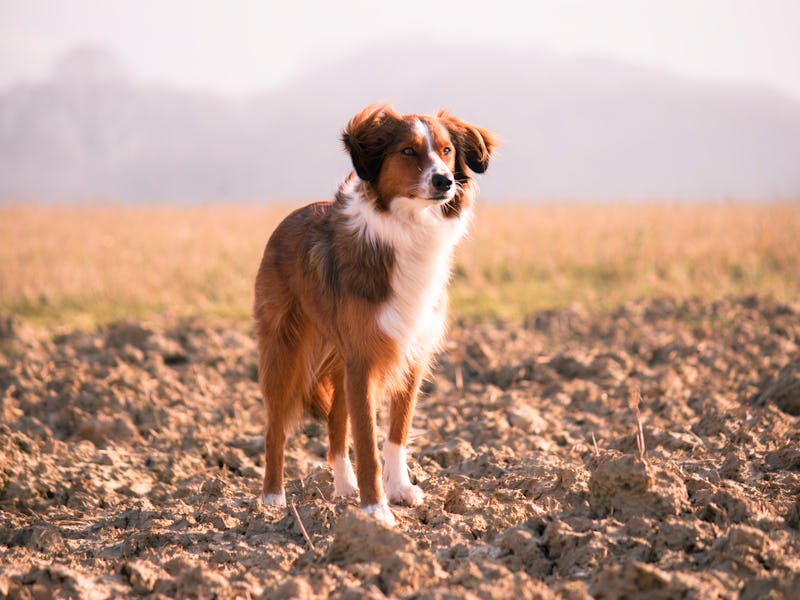Genetics Research Explains Why Dogs Are Very Good Boys
Domesticated dogs and wolves have a genetic mutation that makes them friendly.

There’s something about dogs that truly makes them man’s best friend. Our loyal, slobbering pets rescue those in need and are extremely social, but until Wednesday we never figured out why dogs and humans get along so well.
A study published Wednesday in Science Advances reveals that dog genes made them especially open to domestication and hypersocial behavior. In short, the scientists report that genetic mutations leave dogs in a state of childlike social and cognitive development, where they seek out contact and attention.
Aside from the fact that we give them food and belly rubs, there was no compelling science before this study that explained why dogs like us so much.
“This recent work is providing a possible molecular mechanism that influences social behavior, e.g. friendliness,” Bridgett vonHoldt, an evolutionary biologist from Princeton University who conducted the research, tells Inverse.
By analyzing DNA samples taken from a variety of dogs and wolves, vonHoldt and Monique Udell, a scientist from Oregon State University who studies animal cognition and collaborated on this research project, identified four mutations that seemed to influence social behavior in those dogs. In particular, they found mutations on a gene called WBSCR17, which vonHoldt says she studied back when she was working on her doctoral thesis, and two transcription factor genes.
“We found that these mutations were frequent in many populations and breeds, possibly suggestive of their role in personality variation,” says vonHoldt.
In humans, when that gene is deleted from one of two paired chromosomes, it can lead to a condition called Williams-Beuren Syndrome, which involves stunted social development and overly-friendly behavior, not unlike the traits that separate good little pups from vicious wolves and coyotes.
Such a good boy!
VonHoldt explains that they found a great deal of variability in regards to this mutation when they looked at wolf genetics, but the mutation was almost entirely absent in coyotes. “Some wolves are dog-like in their degree of sociality, while some dogs may also display more wolf-like or less social behaviors,” she says. The differences among wolves could explain how domestication occurred, with friendlier animals living in a closer proximity to people and passing those social genes down to their pups, vonHoldt explains.
This variability was reflected in the behavioral component of the study, where dogs and wolves were tasked with opening a small box that contained a treat within two minutes. In one iteration, the dog or wolf was alone with a box, but in the other condition there was a human — to whose presence the wolves were already accustomed — sitting quietly in a chair.
While the choices made by the wolves were more mixed with a human present, the dogs largely ignored the treat box to stare at the human, often walking over and trying to get their attention instead. While this shift in focus was indicative of the social nature of dogs, the dogs also struggled to open the box when there wasn’t a person around. As such, the genetic mutations that aided in the domestication process are also linked to cognitive deficits in our friendly pups. Thankfully, dogs have us around to grab their treats for them.
Meanwhile, vonHoldt is surveying more and more dog breeds to get a better idea of how these mutations impact gene expression and how that then translates into dog behavior. As a long-time cat person who recently got her first dog, vonHoldt says, “I’d love it if someone wanted to sequence this region in the cat. I think that would answer so many questions about domestic species!”
Abstract: Although considerable progress has been made in understanding the genetic basis of morphologic traits (for example, body size and coat color) in dogs and wolves, the genetic basis of their behavioral divergence is poorly understood. An integrative approach using both behavioral and genetic data is required to understand the molecular underpinnings of the various behavioral characteristics associated with domestication. We analyze a 5-Mb genomic region on chromosome 6 previously found to be under positive selection in domestic dog breeds. Deletion of this region in humans is linked to Williams-Beuren syndrome (WBS), a multisystem congenital disorder characterized by hypersocial behavior. We associate quantitative data on behavioral phenotypes symptomatic ofWBS in humans with structural changes in the WBS locus in dogs. We find that hypersociability, a central feature of WBS, is also a core element of domestication that distinguishes dogs from wolves. We provide evidence that structural variants in GTF2I and GTF2IRD1, genes previously implicated in the behavioral phenotype of patients with WBS and contained within the WBS locus, contribute to extreme sociability in dogs. This finding suggests that there are commonalities in the genetic architecture of WBS and canine tameness and that directional selection may have targeted a unique set of linked behavioral genes of large phenotypic effect, allowing for rapid behavioral divergence of dogs and wolves, facilitating coexistence with humans.